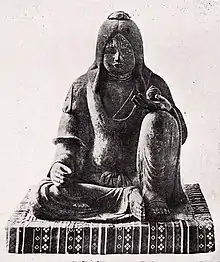Ukanomitama
Ukanomitama is a kami in classical Japanese mythology, associated with food and agriculture, often identified with Inari, the deity of rice.
| Ukanomitama-no-Kami | |
|---|---|
Goddess of food and agriculture | |
 | |
| Other names | Ukanomitama-no-Mikoto (倉稲魂命) Mikura-no-Kami (御倉神) |
| Japanese | 宇迦之御魂神 |
| Major cult center | Fushimi Inari Taisha, Kasama Inari Shrine, Yūtoku Inari Shrine and others |
| Texts | Kojiki, Nihon Shoki and others |
| Personal information | |
| Parents | Susanoo and Kamu-Ōichihime (Kojiki) Izanagi and Izanami (Nihon Shoki) |
| Siblings | Ōtoshi (Kojiki) |
Name and mythology
The Kojiki identifes Ukanomitama (宇迦之御魂神 Ukanomitama-no-Kami) as the child of Susanoo by his second wife Kamu-Ōichihime (神大市比売), a daughter of Ōyamatsumi (大山津見神), the god of mountains. This text portrays Ukanomitama as the younger sibling of the harvest deity Ōtoshi-no-Kami.[1][2]
A variant account recorded in the Nihon Shoki meanwhile portrays Ukanomitama (here referred to as 倉稲魂命 Ukanomitama-no-Mikoto) as an offspring of Izanagi and Izanami who were born when the two became hungry.[3]
The deity's name is understood as being derived from uka no mitama, "august spirit (mitama) of food (uka)".[1][4] While the above texts are silent regarding the deity's gender, Ukanomitama has long been interpreted to be female, perhaps due to association with other agricultural deities such as Toyouke or Ukemochi.
References
- Chamberlain (1882). Section XX.—The August Ancestors of the Deity-Master-Of-The-Great Land.
- Philippi, Donald L. (2015). Kojiki. Princeton University Press. p. 92.
- Aston, William George (1896). . Nihongi: Chronicles of Japan from the Earliest Times to A.D. 697. Kegan Paul, Trench, Trübner & Co. p. – via Wikisource.
- Philippi, Donald L. (2015). Kojiki. Princeton University Press. p. 621.
Bibliography
- Aston, William George, tr. (1896). Nihongi: Chronicles of Japan from the Earliest Times to A.D. 697. London: Kegan Paul, Trench, Trübner & Co.
- Chamberlain, Basil, tr. (1882). A Translation of the "Ko-Ji-Ki," or "Records of Ancient Matters". Yokohama: Lane, Crawford & Co.
- Philippi, Donald L. (2015). Kojiki. Princeton University Press. ISBN 978-1400878000.